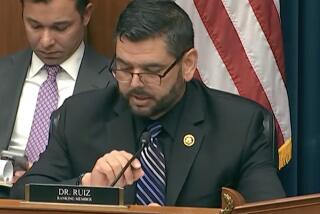New Tobacco Records: Did Industry Know Risks Early?
- Share via
“Certain scientists and medical authorities have claimed for many years that the use of tobacco contributes to cancer development in susceptible people,” the letter said.
“Just enough evidence has been presented to justify the possibility of such a presumption,” it added.
The writer was not a tobacco industry critic, but a tobacco company chemist. The year was 1946 and the chemist, Harris B. Parmele, who worked for Lorillard and wrote that letter to a Lorillard official, would go on to become the company’s vice president for research and a member of its board of directors.
The Parmele letter--written 18 years before the U.S. surgeon general’s report and 20 years before warning labels appeared on cigarette packs--is among a flurry of intriguing documents to surface in a history-making cigarette liability trial in Newark, N.J., now in its third month.
Internal Documents Revealed
For the first time in a smoker-death case, jurors have been exposed to a blizzard of confidential letters, reports and strategy memos, culled from more than 100,000 internal documents that have been obtained by plaintiff lawyers through hard-fought discovery battles. These documents also will be available in other cigarette lawsuits, of which about 120 are pending across the country.
The trial, expected to end in May, stems from the lung cancer death of Rose Cipollone, 58, a smoker for 40 years. Her husband, Antonio, is seeking unspecified damages from Philip Morris, Lorillard, and Liggett & Myers--producers of the brands she smoked.
According to the surgeon general, smoking causes 350,000 premature deaths a year in the U.S. from cancer, heart and lung disease. Cigarette firms, which so far have not lost a lawsuit, are unwavering in their claim that smoking hasn’t been proven to cause any human ailment.
But documents in this case appear to suggest that the cigarette makers knew early on about the risks of smoking; sponsored research knowing it was good public relations and secretly worked on, but failed to introduce, less hazardous types of cigarettes--all the while denying a need for them.
“We’re dealing with bad actors,” said Richard Daynard, a Boston law professor who heads a research and support group for lawyers who sue the tobacco industry.
Gleeful foes see tobacco nearing the same day of reckoning as the asbestos industry, which also beat back the first wave of suits until a series of “smoking guns”--damning internal documents--led to courtroom defeats, stiffer asbestos regulation and finally the tidal wave of suits that dragged the industry down.
Some experts reject the parallel, however, pointing to the $35-billion-a-year cigarette industry’s vast financial strength and the difficulty of proving in each case that smoking caused a specific person’s disease. More to the point, industry officials say, the internal documents are no real threat. They say snippets have been misinterpreted and taken out of context to create an impression of sinister intent.
“I do not believe there is damning evidence in those documents,” said Chuck Wall, an attorney acting as spokesman for industry leader Philip Morris and Lorillard. “There are no smoking guns.”
“I think that the jury will see at the end of the trial that the companies acted responsibly,” said Liggett spokesman Alan Hilburg.
But some disclosures are bound to prove embarrassing.
In a 1952 list of research goals, a Philip Morris scientist gave a low priority to research “to determine the effect of smoke as an etiologic (causal) factor in carcinoma (cancer).”
In a 1954 memo, a scientific consultant to Liggett discussed a massive American Cancer Society study on smoking and health. “The findings demonstrated unequivocally that deaths from coronary heart disease were about double in cigarette smokers vs. nonsmokers.” The memo went on: “Figures for lung cancer should settle the argument for a long time.”
Other Hazards Considered
A 1956 memo from the Philip Morris research department to top executives at the company discussed the value of lowering carbon monoxide yield. “Decreased carbon monoxide and nicotine are related to decreased harm to the circulatory system as a result of smoking,” the memo said. “Decreased irritation is desirable not only from the subjective viewpoint but also as a partial elimination of a potential cancer hazard.”
A memo the following year from Philip Morris scientists described ventilated cigarettes as having “many demonstrated and potential health advantages relating to cancer and heart.”
In October, 1963--three months before the surgeon general’s landmark report on smoking and lung cancer--Philip Morris’ vice president for research warned that cancer might not be the worst of it. In a letter to a top executive outlining “areas where the cigarette industry might be most subject to criticism,” Dr. Helmut Wakeham described emphysema and chronic bronchitis as “serious diseases involving millions of people.
“Emphysema,” Wakeham wrote, “is often fatal directly or through other respiratory complications. A number of experts have predicted that the cigarette industry ultimately may be in greater trouble in this area than in the lung cancer field.”
Wall, the spokesman for Philip Morris and Lorillard, said the authors of these letters were not conceding that smoking causes disease. Parmele, he said, was merely pointing out in 1946 that a smoking and cancer link “is a theory that’s been advanced.” And Wakeham, according to Wall, “was saying that critics were claiming” cigarettes caused disease.
Other documents discuss specific toxic and cancer-causing substances contained in cigarette smoke.
A 1959 memo from Philip Morris said that if the Food and Drug Administration got authority over cigarettes, “certain constituents, like arsenic and other insecticides, . . . might have to be controlled.”
In “Tobacco and Health--R&D; Approach,” a 1961 report by Wakeham, he presented a “partial list” of carcinogens found in cigarette smoke. It included 40 compounds.
The same year, a memo from Liggett’s scientific consultants, Arthur D. Little, Inc., declared: “There are biologically active materials present in cigarette tobacco. These are: a) cancer causing; b) cancer promoting; c) poisonous; d) stimulating, pleasurable, and flavorful.”
Wall said industry scientists were only discussing substances “identified in the public literature as having caused cancer in an animal. Not humans.”
Following the famous 1953 experiment in which cancerous tumors appeared on mice whose backs were painted with tobacco tar, the industry turned to research to ease the minds of jittery smokers.
In January, 1954, ads in 448 newspapers announced creation of a Tobacco Industry Research Committee to provide grants for independent research on smoking and health. Tobacco companies didn’t believe their products were harmful, the ads said, but were determined to get to the truth. If there was anything harmful in tobacco, they’d find it and take it out.
The industry also provided millions of dollars for research to the American Medical Assn. and various universities. By 1983, the cigarette makers could boast of spending $120 million on independent research.
Motives Questioned
But internal documents raise questions about the motives underlying the research.
For years, the industry research committee--later renamed the Council for Tobacco Research--was based in the same New York office building as Hill & Knowlton, which doubled as public relations counsel for the CTR and the industry. Several documents described the research council’s role in repelling attacks on smoking.
One Lorillard document called the council the “best and cheapest insurance the tobacco industry can buy and without it the industry would have to invent CTR or would be dead.”
According to a 1962 memo, CTR had “carried its fair share of the public relations load in providing materials to stamp out the brush fires as they arose . . . The public relations problem . . . was like the early symptoms of diabetes--certain dietary controls kept public opinion reasonably healthy. When some new symptom appeared, a shot of insulin in the way of a news release, a . . . television rebuttal, etc., kept the patient going.”
In a 1974 letter to Lorillard chief executive Curtis H. Judge, company research director Alexander W. Spears said the industry-sponsored research “provided some buffer to public and political attack.”
Others were less enthralled. “Our medical research support efforts through CTR and AMA have been confusing and contradictory in the public eye because we have on the one hand proclaimed these endeavors to be aimed at ‘finding the truth about smoking and health’ and at the same time denied the existence of a problem,” Dr. Wakeham of Philip Morris wrote.
“Nobody believes we are interested in the truth on this subject; and the fact that a multibillion dollar industry has put up $30 million for this over a 10-year period cannot be impressive to a public which at the same time is told we spend upwards of $300 million in one year on advertising.”
According to Wall, Wakeham was saying, in essence: “Nobody believes the tobacco industry . . . We’ve got to get more money into the research areas.”
Other documents suggest the industry sought to muffle scientific critics.
In a 1964 memo, James C. Bowling, a top Philip Morris executive, noted that several cigarette firms had made “substantial contributions” to the Sloan-Kettering Institute for Cancer Research, the base of Dr. Ernst Wynder, author of the mouse skin painting study. Lately, Bowling wrote, Sloan-Kettering officials had been “subjecting Wynder to (a) more rigorous screening procedure before letting him speak in the name of the institute. This has had a proper and pleasing effect.”
Act of Sabotage
In another memo, a public relations consultant to the CTR told how he sabotaged the press conference of a scientist who had induced laryngeal tumors in hamsters that breathed tobacco smoke. The briefing was to take place at a scientific meeting in Atlantic City in April, 1974, but the public relations man said he persuaded a meeting official to cancel the briefing and tell the scientist the press room was already booked.
The day after the canceled briefing, the scientist, Dr. Freddy Homburger, showed up in the press room, apparently looking for reporters he knew.
“I had expected something like this and had talked in advance with the head of the press room,” Leonard S. Zahn wrote. “Homburger was given a cordial welcome and nicely ‘hastened’ out the door.”
According to Wall, however, Zahn believed Homburger--who had received CTR funds--was spreading false stories that the research council was trying to suppress his findings.
Other documents discuss the habit-forming properties of nicotine, which is critical to plaintiffs, who must show why they went on smoking despite prominent warnings.
William L. Dunn Jr., Ph.D., a former psychologist with Philip Morris, wrote in a paper introduced into evidence, “Think of the cigarette pack as a storage container for a day’s supply of nicotine,” he wrote. “Think of the cigarette as a dispenser for a dose unit of nicotine.”
Another Dunn memo suggested in 1973 that smokers seeking a health advantage by switching to milder brands might be no better off. They tended to smoke more cigarettes and smoke them further down, perhaps “to compensate for the decreases in the tar and nicotine delivery,” the document said.
Other documents show that all three companies were interested in developing non-cancer-causing cigarettes.
Liggett’s work in the area consumed 20 years and more than $14 million. According to Dr. James D. Mold, Liggett’s assistant research director until 1979, the project was successful but the company decided not to market the cigarette due to pressure from company lawyers.
“They felt that such a cigarette if put on the market would seriously indict them for having sold other types of cigarettes,” Mold said in his videotaped deposition.
Mold described how scientists at Liggett and Arthur D. Little found an additive to neutralize the cancer-causing compounds in the tar of tobacco smoke. The additive was a mixture of magnesium nitrate and palladium--a metal used in auto catalytic converters to reduce exhaust. In mouse skin painting studies using tar from palladium nitrate tobacco, cancers were reduced up to 100%. Mold said his group also concluded through tests that the palladium did not present new risks.
Mold described “a schizophrenia” at Liggett, where top management was supportive but the legal staff “would pounce upon . . . any problem . . . in an attempt to kill the project.”
Hilburg, the Liggett spokesman, described Mold as “obsessed” with the palladium nitrate project and embittered at being passed over for the job of research director. He said that when Liggett sought support for the development, health officials gave “no encouragement at all” and “criticized (the idea of) adding a heavy metal, palladium, to tobacco.”
In 1978, when Liggett got a patent on the palladium nitrate development, several news stories suggested the company had acknowledged that cigarettes cause cancer.
The firm quickly put out a “LiggettGram”--or press release--denying such an admission. “It has never been established that smoking is a cause of human cancer,” the release said.
Liggett president Kinsley V. Dey Jr. took the same tack in his deposition, saying the palladium-nitrate work was not meant to prevent human cancer. Dey insisted the work was intended solely to “reduce tumors formed from smoke condensate on the backs of mice.”
Question: It had nothing to do with the health and welfare of human beings; is that correct?
Answer: That’s correct.
Q: Do you know how much that study cost, sir?
A: A lot of money through the years.
Q: And this was to save rats, right? Or mice? You spent all this money to save mice the problem of developing tumors; is that correct?
A: I have stated what we did.
Q: Am I correct, sir?
A: We were there to try to show that the smoke condensate on the backs of mice were treated with tobacco would reduce the tumors on the backs of mice. It has never been proven that you can extrapolate from mice to man.
More to Read
Sign up for Essential California
The most important California stories and recommendations in your inbox every morning.
You may occasionally receive promotional content from the Los Angeles Times.










